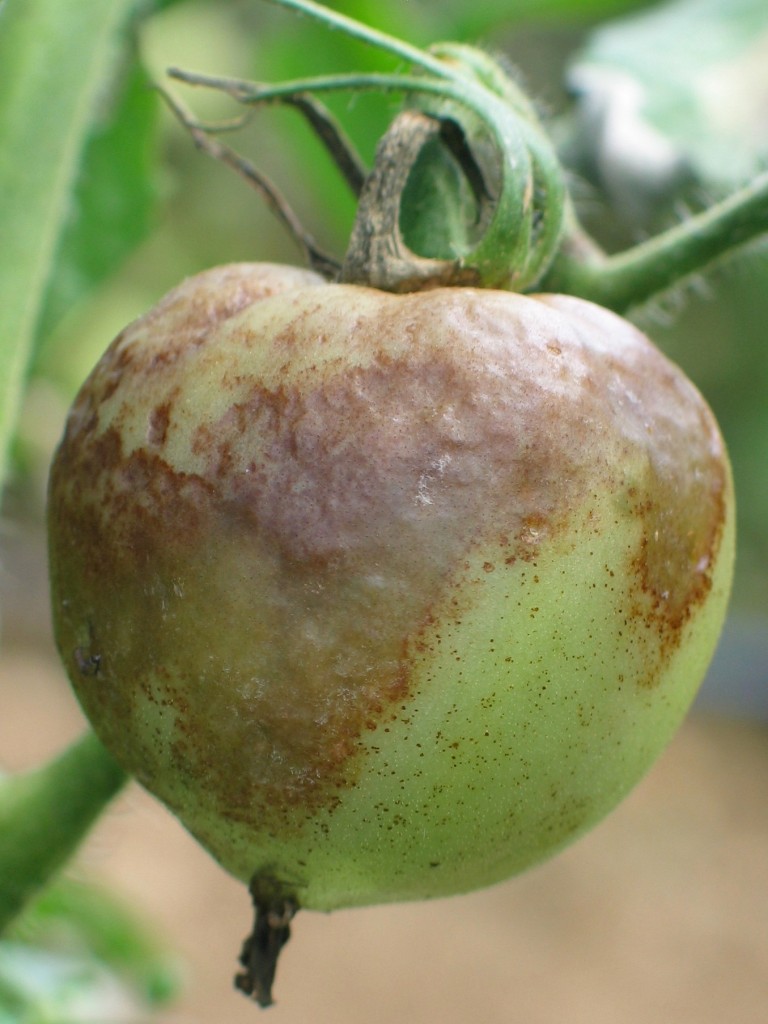While gardeners and farmers elsewhere, including upstate New York, have been battling late blight in 2015, so far it hasn’t been found on Long Island! At least, not yet . . . This is the first year since 2008 that this highly contagious and very destructive disease of tomatoes and potatoes hasn’t been observed here in spring and summer. Its absence means that on Long Island, we are successfully managing plant sources of the late-blight pathogen, Phytophthora infestans, in three ways by:
- not planting infected potato tubers to grow new crops
- not leaving infected potato tubers from previous crops in the ground or putting them in cull or compost piles
- not planting infected tomato seedlings
But one source of late blight remains on the scene and continues to be a threat until frost: spores blown long distances by wind. Typically spores of Phytophthora infestans blow no more than about 30 miles, but their farther wind dispersal is possible. A Long Island outbreak of late blight in August 2007 was, I think, the result of a storm carrying spores here from Lancaster, Pennsylvania. And in October of 2002 and 2008, late blight made its first appearance of the year on Long Island. There have been reports recently of late blight in New Jersey, so we’re not out of the woods yet.
Here is when late blight was first observed on Long Island in recent years:
- October 3, 2002
- July 5, 2006
- Aug 26, 2007
- October 3, 2008
- June 23, 2009
- June 18, 2010
- June 24, 2011
- May 29, 2012
- July 25, 2013
- June 20, 2014
Do you want to know where late blight has been reported in the United States this year? Check out www.usablight.org. Anyone can sign up on this website to get an alert by text or e-mail when a report has been logged nearby, so you can be one of the first to know when late blight has been found on Long Island. But realize your plants could be the first affected; therefore, signing up for alerts is not a substitution for looking for symptoms at least once a week. My own garden plants were part of the August 2007 outbreak!
Considering the potential impact of late blight, everyone who grows tomatoes and potatoes is responsible for inspecting their plants for late blight, reporting it when seen, and managing affected plants to minimize its spread. Photographs and information about late blight are posted on my website at: http://livegpath.cals.cornell.edu/gallery/tomato/tomato-late-blight/
If you see symptoms you think might be late blight (rather than one of its imitators, also shown on my website) call our Horticulture Diagnostic Lab at our hot line at 631-727-4126 from 9 a.m. to noon, Monday through Friday, where Alice Raimondo and Sandra Vultaggio, our Horticulture Consultants, can help determine whether you do, indeed, have late blight, even this late in the year.
Dr. Meg McGrath is Associate Professor at Cornell University’s Long Island Horticulture Research and Extension Center in Riverhead, New York, where she conducts research and extension activities to help farmers manage diseases.

